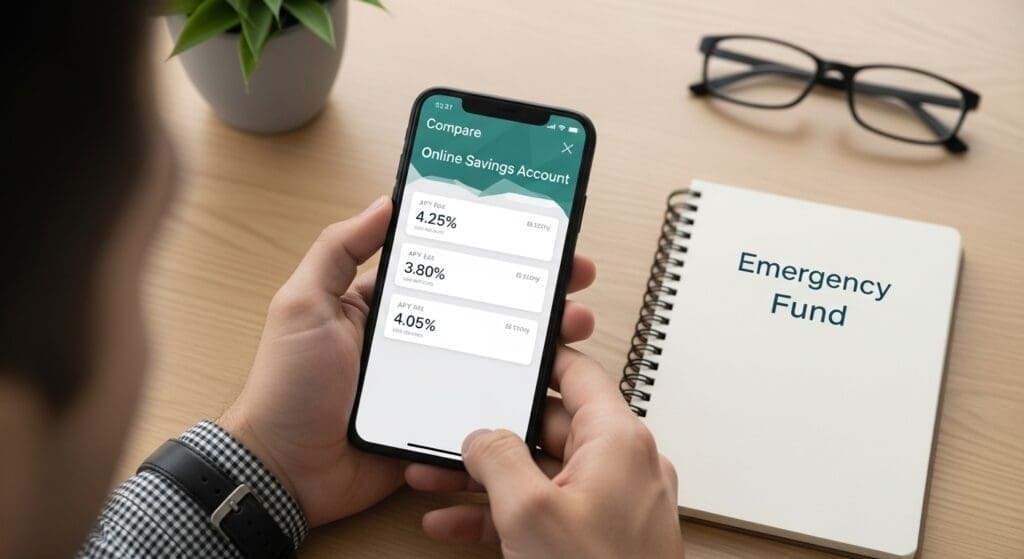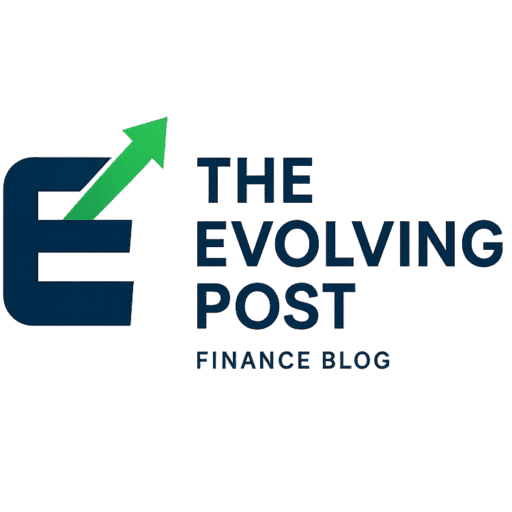Best High-Yield Savings Accounts 2025 are offering over 4% APY in 2025—rates we haven’t seen in over a decade. But these exceptional returns won’t last forever. As the Federal Reserve considers rate cuts later this year, now is the perfect time to lock in these earnings and make your cash work harder than it has in years.
Table of Contents
- Why 2025 is the Golden Year for High-Yield Savings
- Top High-Yield Savings Accounts July 2025
- How Much You Can Actually Earn
- Choosing the Right Account for Your Goals
- Maximizing Your High-Yield Savings Strategy
- What to Watch for in Rate Changes
- Canadian High-Yield Options
- Frequently Asked Questions
Why 2025 is the Golden Year for High-Yield Savings
The Perfect Storm of High Rates
We’re living through a unique financial moment. After years of near-zero interest rates from 2009 to 2021, the Federal Reserve’s aggressive rate hikes to combat inflation have created an opportunity that many thought was gone forever: savings accounts that actually pay meaningful returns.
The Numbers Don’t Lie
According to the FDIC’s latest data, the average savings account APY across all banks is still just 0.6%. But online banks are offering rates that are 7x higher:
- Traditional banks: 0.01% – 0.6% APY
- Online high-yield accounts: 4.0% – 4.4% APY
- Credit unions: 2.5% – 3.8% APY
Why Online Banks Can Offer More
Online banks have a massive advantage: lower overhead costs. Without physical branches, they can pass those savings directly to customers through higher interest rates. They’re also more agile, adjusting rates quickly to stay competitive in the market.
The Ticking Clock
Here’s the reality check: these rates are tied to Federal Reserve policy. When the Fed cuts rates (which many economists expect in late 2025), high-yield savings rates will follow. The window for earning 4%+ on your savings is narrowing.
Top High-Yield Savings Accounts July 2025
Our Top Picks Based on APY and Features
| Bank | APY | Minimum Balance | Monthly Fee | Sign-up Bonus | FDIC Insured |
|---|---|---|---|---|---|
| LendingClub LevelUp Savings | 4.40% | $0 | $0 | None | Yes |
| Forbright Bank Growth Savings | 4.25% | $0 | $0 | None | Yes |
| Barclays Tiered Savings | 3.90% | $0 | $0 | None | Yes |
| SoFi Checking & Savings | 3.80% | $0 | $0 | Up to $300 | Yes |
| Capital One 360 Performance | 3.50% | $0 | $0 | None | Yes |
Detailed Account Analysis
LendingClub LevelUp Savings – 4.40% APY
Why it’s our top pick:
- Highest APY available as of July 2025
- No minimum balance requirements
- No monthly maintenance fees
- Easy online account opening
- Mobile app with excellent reviews
Potential drawbacks:
- No physical branches
- Limited customer service hours
- APY subject to change without notice
Forbright Bank Growth Savings – 4.25% APY
Strong second choice:
- Consistently competitive rates
- Excellent customer service ratings
- User-friendly online platform
- Quick fund transfers
Consider this if:
- You value customer service
- You prefer established online banks
- You want rate stability
SoFi Checking & Savings – 3.80% APY + Bonuses
Best for new customers:
- Up to $300 sign-up bonus with direct deposit
- No account fees
- Additional perks like financial planning tools
- Strong mobile app
Bonus structure:
- $50 bonus with $500+ direct deposit
- $150 bonus with $1,000+ direct deposit
- $300 bonus with $5,000+ direct deposit

How Much You Can Actually Earn
Real-World Earnings Examples
Let’s break down what these rates mean for your actual money:
Emergency Fund Scenario
Amount: $15,000 (recommended 3-6 months expenses)
- At 4.40% APY: $660 per year
- At 0.6% traditional bank: $90 per year
- Difference: $570 extra per year
Home Down Payment Scenario
Amount: $50,000 (saving for a house)
- At 4.40% APY: $2,200 per year
- At 0.6% traditional bank: $300 per year
- Difference: $1,900 extra per year
Retirement Bridge Scenario
Amount: $100,000 (between jobs or early retirement)
- At 4.40% APY: $4,400 per year
- At 0.6% traditional bank: $600 per year
- Difference: $3,800 extra per year
The Compound Effect
These aren’t just one-year gains. With compound interest, your money grows on top of previous growth:
$25,000 invested at 4.40% APY:
- Year 1: $26,100
- Year 2: $27,248
- Year 3: $28,448
- Total gain over 3 years: $3,448
Compare that to a traditional savings account at 0.6%:
- Total gain over 3 years: $453
- You’d miss out on: $2,995
Tax Considerations
Important note: Interest earned on savings accounts is taxable income. You’ll receive a 1099-INT form if you earn more than $10 in interest per year.
Tax planning tips:
- Consider maxing out tax-advantaged accounts first (401k, IRA)
- For Canadians: Interest is taxable, but TFSA accounts offer tax-free growth
- Keep records of interest earned for tax filing
Choosing the Right Account for Your Goals
Emergency Fund Strategy
Best choice: LendingClub LevelUp Savings (4.40% APY)
Why it works:
- Highest return on money you hope to never use
- No minimum balance (perfect for building up slowly)
- Easy access when emergencies strike
- FDIC insured up to $250,000
How much to save:
- Minimum: 3 months of expenses
- Recommended: 6 months of expenses
- High earners/contractors: 9-12 months of expenses
Short-Term Savings Goals
Best choice: Forbright Bank Growth Savings (4.25% APY)
Perfect for:
- Vacation funds (6-18 months out)
- Car down payments
- Wedding expenses
- Home improvement projects
Strategy:
- Set up automatic transfers
- Calculate your monthly savings needed
- Let compound interest boost your progress
Large Cash Holdings
Best choice: Multiple accounts to maximize FDIC coverage
If you have over $250,000:
- Split between multiple FDIC-insured banks
- Consider LendingClub + Forbright + Barclays
- Each account covers up to $250,000
- Maintain the highest possible APY across all accounts
Sign-Up Bonus Optimization
Best choice: SoFi Checking & Savings
Strategy:
- Set up direct deposit for maximum bonus
- Keep account open for required period
- Calculate if bonus beats higher APY over time
Example calculation:
SoFi: 3.80% APY + $300 bonus vs. LendingClub: 4.40% APY
- On $25,000: SoFi earns $950 + $300 = $1,250 first year
- LendingClub earns $1,100 first year
- SoFi wins by $150 in year one
Maximizing Your High-Yield Savings Strategy
Automation is Your Friend
Set Up Automatic Transfers
From checking to savings:
- Transfer immediately after payday
- Start with $100-500 per month
- Increase by $50 every 3 months
- “Pay yourself first” mentality
Example automation schedule:
- Day 1: Paycheck deposits
- Day 2: Automatic transfer to high-yield savings
- Day 3: Pay bills from remaining checking balance
Direct Deposit Splitting
Many employers allow you to split direct deposit:
- 80% to checking (for bills and expenses)
- 20% to high-yield savings (for goals and emergency fund)
The Bucket Strategy
Organize Multiple Savings Goals
Account 1: Emergency Fund
- 3-6 months expenses
- Highest APY account
- Only touch for true emergencies
Account 2: Short-Term Goals
- Vacation, car, home improvements
- Second-highest APY
- Specific timeline and target amount
Account 3: Opportunity Fund
- Investment opportunities
- Market downturns
- Unexpected deals or purchases
Rate Shopping and Monitoring
Stay Informed About Rate Changes
Monthly check-ins:
- Review your current APY
- Compare with top competitors
- Consider switching if gap is 0.25%+
Tools to track rates:
- Bank websites (check monthly)
- Financial comparison sites
- Rate alert services
- Banking apps with rate tracking
When to Switch Accounts
Switch if:
- New bank offers 0.25%+ higher APY
- Your current bank drops rates significantly
- Better sign-up bonuses become available
- Customer service issues persist
Don’t switch if:
- Rate difference is less than 0.10%
- You’d lose a significant sign-up bonus
- Transfer fees outweigh benefits
What to Watch for in Rate Changes
Federal Reserve Policy Impact
How Fed Decisions Affect Your Savings
The Federal Reserve’s Federal Open Market Committee meets eight times per year. Their decisions directly impact high-yield savings rates:
When Fed raises rates:
- High-yield savings APYs typically increase within 1-2 weeks
- Online banks usually move faster than traditional banks
- Rate increases often 0.75-1.0x the Fed increase
When Fed cuts rates:
- Savings APYs drop quickly (sometimes within days)
- Banks are faster to cut rates than raise them
- Your 4.40% APY could become 3.40% overnight
2025 Fed Outlook
According to Federal Reserve economic projections:
- Current Fed funds rate: 5.25-5.50%
- Expected 2025 cuts: 0.50-0.75% total
- Timeline: Likely starting Q4 2025
- Impact on savings: Rates could drop to 3.5-3.8% range
Economic Indicators to Monitor
Inflation Data
Key reports to watch:
- Consumer Price Index (CPI): Monthly inflation measure
- Core CPI: Excludes food and energy
- Personal Consumption Expenditures (PCE): Fed’s preferred inflation gauge
What it means:
- Falling inflation = higher chance of Fed rate cuts
- Rising inflation = rates may stay high longer
Employment Data
Monthly jobs report impact:
- Strong job growth = Fed may keep rates high
- Weak job growth = pressure for rate cuts
- Unemployment rate changes affect Fed policy
Banking Industry Trends
Competition among banks:
- New online banks entering market
- Existing banks fighting for deposits
- Promotional rates and sign-up bonuses
Regulatory changes:
- FDIC insurance limit changes
- Banking regulations affecting online banks
- Consumer protection updates
Timing Your Moves
When to Lock in Current Rates
Act quickly if:
- Fed signals upcoming rate cuts
- Economic data shows weakening trends
- Your target bank announces rate reductions
Take your time if:
- Rates are stable or rising
- New competitors entering market
- Sign-up bonuses are increasing

Canadian High-Yield Options
Top Canadian High-Yield Savings Accounts
Best Canadian Options
| Bank | APY | Minimum Balance | Monthly Fee | Features |
|---|---|---|---|---|
| Tangerine Savings | 3.25% | $0 | $0 | Promotional rates for new customers |
| Simplii Financial HISA | 3.00% | $0 | $0 | No-fee banking package |
| Koodo Financial | 2.80% | $0 | $0 | Digital-first banking |
| Motive Financial | 2.75% | $0 | $0 | Consistent competitive rates |
Tax-Free Savings Account (TFSA) Strategy
TFSA advantages:
- 2025 contribution limit: $7,000
- Lifetime limit: $95,000 (if eligible since 2009)
- Tax-free growth: No tax on interest earned
- Flexible withdrawals: Can withdraw and re-contribute
TFSA high-yield options:
- Tangerine TFSA: 3.25% APY (promotional)
- Simplii TFSA: 3.00% APY
- EQ Bank TFSA: 2.50% APY
Canadian vs. US Rate Comparison
Why Canadian rates are lower:
- Bank of Canada rate: 2.75% (vs. US Fed rate: 5.25%)
- Different economic conditions
- Banking system structure differences
Canadian advantage:
- TFSA tax-free growth
- More stable banking system
- CDIC insurance protection
Cross-Border Considerations
US Citizens Living in Canada
Tax implications:
- Must report US bank interest to IRS
- May face withholding taxes
- Consider tax-treaty benefits
Banking access:
- Some US banks restrict Canadian residents
- Online banks may have geographic limits
- Currency conversion costs
Canadians with US Accounts
Reporting requirements:
- Report foreign accounts over $10,000 CAD
- Potential tax implications
- Currency exchange considerations

Frequently Asked Questions
Are high-yield savings accounts safe?
Yes, when they’re FDIC-insured (US) or CDIC-insured (Canada). Your deposits are protected up to $250,000 USD or $100,000 CAD per bank, per depositor. All the accounts we recommend carry this insurance.
The risk isn’t losing your money—it’s that interest rates can change. Unlike CDs, high-yield savings accounts have variable rates that can go up or down.
How often do interest rates change on these accounts?
Interest rates on high-yield savings accounts can change at any time, but typically adjust:
- Within 1-2 weeks of Federal Reserve rate changes
- Monthly or quarterly based on market competition
- Immediately during promotional periods
Banks are required to notify you of rate changes, but they’re not required to give advance notice.
Should I move all my money to a high-yield savings account?
Not necessarily. Consider this allocation strategy:
- Checking account: 1-2 months of expenses (for bills and daily spending)
- High-yield savings: 3-6 months of expenses (emergency fund)
- Investment accounts: Long-term savings (retirement, goals 5+ years out)
High-yield savings are perfect for money you need to access within 1-5 years, but long-term wealth building requires investment accounts.
What happens if the bank fails?
If an FDIC-insured bank fails, the FDIC steps in to protect depositors:
- Up to $250,000 per depositor, per bank is guaranteed
- Funds typically available within a few business days
- No cost to depositors for this protection
This is why it’s important to stay under the $250,000 limit per bank and only use FDIC-insured institutions.
Can I lose money in a high-yield savings account?
You cannot lose your principal in an FDIC-insured high-yield savings account. However, you can lose purchasing power if:
- Inflation exceeds your interest rate
- Rates drop significantly after you deposit money
Currently, with 4%+ APYs and inflation around 3%, you’re earning real returns above inflation.
How do I switch banks without losing interest?
Step-by-step switching process:
- Open new account before closing old one
- Transfer funds via ACH (usually free)
- Update automatic transfers to new account
- Wait for final interest payment from old account
- Close old account after confirming everything transferred
Timing tip: Switch early in the month to maximize interest earned in both accounts.
Are there any fees I should watch out for?
Most high-yield savings accounts have minimal fees, but watch for:
- Monthly maintenance fees (rare but possible)
- Excessive withdrawal fees (over 6 per month)
- Wire transfer fees ($15-30 typical)
- Account closure fees (some banks charge if closed quickly)
All our recommended accounts have no monthly fees and minimal other charges.
How long do promotional rates last?
Promotional rates vary by bank:
- Tangerine (Canada): Typically 5-6 months for new customers
- SoFi bonuses: Usually require 60-90 days of direct deposit
- Standard rates: Can change anytime but tend to be more stable
Strategy: Take advantage of promotional rates, but don’t rely on them long-term. Always have a backup plan for when rates normalize.
ant to Keep Strengthening Your Finances?
Want to Keep Strengthening Your Finances?
If you found this article helpful, you might enjoy some of our other popular posts that dive deeper into saving, investing, and smart money management:
- 6 Financial Strategies to Protect Your Wealth
- Best No-Penalty CD Rates of 2025
- 8 Powerful Financial Strategies Every Single Person Should Know
- The 10 Best Financial Wellness Apps That Track Mental Health in 2025
- The 10 Best Financial Wellness Apps That Track Mental Health in 2025
- 2025 401(k) Limits: Save $34,750 + Super Catch-Up Guide
Keep exploring — your smartest financial years are just getting started
Sources:
- Federal Reserve Economic Data
- FDIC National Rates and Rate Caps
- Federal Reserve Monetary Policy
- Bank of Canada Interest Rates
- Bureau of Labor Statistics Consumer Price Index
- LendingClub Bank
- SoFi Banking
- Forbright Bank
- Barclays US Consumer Bank
- Capital One Banking
Disclaimer: This article is for educational purposes only and does not constitute financial advice. Interest rates and account terms are subject to change. Always verify current rates and terms directly with financial institutions before making decisions. Consider consulting with a qualified financial advisor for personalized guidance.




